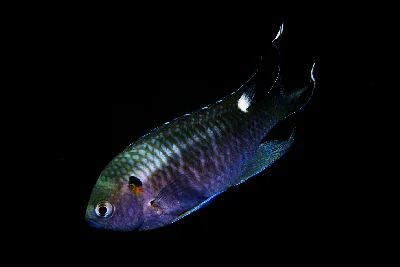Regal Damselfish
Neopomacentrus cyanomos
The Regal Demoiselle, scientifically known as Neopomacentrus cyanomos, is a fascinating marine species recognized for its vibrant presence in tropical waters. Often referred to as the Regal Damselfish, this fish is primarily found in association with coral reefs, where it thrives within a depth range of 5 to 30 meters. Growing to a maximum length of 10 centimeters, it is a small but striking creature that contributes to the vivid tapestry of reef life.
These fish are typically seen inhabiting both inshore and offshore coral environments, including harbors and protected outer reef slopes. They are well-suited to habitats that experience significant water movement, forming schools that extend from just below the water's surface to depths of around 25 meters. As a non-migratory species, they remain relatively stationary within their chosen environments.
Neopomacentrus cyanomos is principally diurnal, meaning they are active during the day. Their reproductive behavior showcases distinct pairing during breeding, a common trait among oviparous fish. The eggs they lay are demersal, adhering firmly to the substrate of their habitat. An interesting aspect of their reproductive cycle is the role of the male fish, who diligently guards and aerates the eggs to ensure their survival.
The geographic distribution of the Regal Demoiselle spans a wide area in the Indo-West Pacific. Their range includes the 🌊 Persian Gulf and the 🌊 Red Sea, extending towards East Africa and the 🇵🇭 Philippines, and further reaching north to southern 🇯🇵 Japan and south to northern 🇦🇺 Australia and Melanesia, though notably absent from 🇫🇯 Fiji.
The name "Neopomacentrus" reveals an intriguing etymological origin, combining elements from Greek—'neos' meaning new, 'poma' for cover or operculum, and 'kentron' meaning sting—illustrating the unique characteristics and perhaps the defensive nature of this vibrant fish. Overall, the Regal Demoiselle represents a remarkable example of coral reef biodiversity, with its distinct behaviors and wide distribution highlighting the complexity and interconnections within marine ecosystems.
Comments
Please, sign in to leave comment
No Comments yet
Last Update: May 28, 2025

